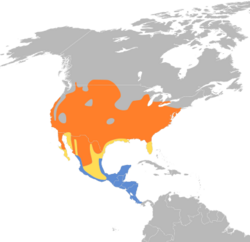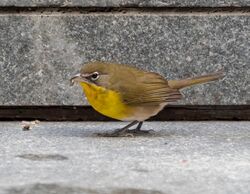Biology:Yellow-breasted chat
| Yellow-breasted chat | |
|---|---|

| |
| Near the Siskiyou Mountains, Oregon | |
| Scientific classification | |
| Domain: | Eukaryota |
| Kingdom: | Animalia |
| Phylum: | Chordata |
| Class: | Aves |
| Order: | Passeriformes |
| Superfamily: | Emberizoidea |
| Family: | Icteriidae Baird, 1858 |
| Genus: | Icteria Vieillot, 1808 |
| Species: | I. virens
|
| Binomial name | |
| Icteria virens | |

| |
| Synonyms | |
|
Turdus virens Linnaeus, 1758 | |
The yellow-breasted chat (Icteria virens) is a large songbird found in North America, and is the only member of the family Icteriidae. It was once a member of the New World warbler family, but in 2017, the American Ornithological Society moved it to its own family. Its placement is not definitively resolved.
Taxonomy
The yellow-breasted chat was formerly considered the largest member of the family Parulidae, but following taxonomic studies, it was moved to the monotypic family Icteriidae. Although Icteriidae is a distinct family from the New World blackbirds (Icteridae), which have a very similar name, taxonomic studies support them as being the closest living relatives of one another, and in a 2019 study[2] Carl Oliveros and colleagues actually classified the yellow-breasted chat as a member of Icteridae. In addition, the former grouping of the yellow-breasted chat as a warbler was not too far off because phylogenomic studies[2][3] have placed Parulidae as sister to a clade that includes Icteridae. Those results make it reasonable to view Parulidae the sister group to the clade comprising Icteridae and Icteriidae, as in Oliveros et al.[2]
Distribution and habitat
The yellow-breasted chat is found throughout North America. It breeds from the southern plains of Canada to central Mexico, and mainly migrates to Mexico and Central America for the winter, although some may overwinter in coastal areas farther north. This species occurs in areas where dense shrubbery is common. Today, its habitat often consists of abandoned farmland and other rural areas where overgrown vegetation proliferates.
Description
If they are considered part of the family Parulidae (New World warblers), yellow-breasted chats are the largest species of parulid. In fact, they can often weigh more than twice as much as other parulid species, but their membership in this taxonomic family is disputed.
This species reaches a total length of 17 to 19.1 cm (6.7 to 7.5 in) and a wingspan of 23 to 27 cm (9.1 to 10.6 in). Body mass can range from 20.2 to 33.8 g (0.71 to 1.19 oz). Among standard measurements, the wing chord is 7.1 to 8.4 cm (2.8 to 3.3 in), the elongated tail is 6.9 to 8.6 cm (2.7 to 3.4 in), the relatively long, heavy bill is 1.3 to 1.6 cm (0.51 to 0.63 in), and the tarsus is 2.5 to 3.1 cm (0.98 to 1.22 in).[4] These birds have olive upper parts with white bellies and bright-yellow throats and breasts. Other signature features of yellow-breasted chats are their large, white eye rings, and blackish legs. When seen, this species is unlikely to be mistaken for any other bird.
Biology

The yellow-breasted chat is a shy, skulking species of bird, often being heard but not seen. The breeding habitats of this species are dense, brushy areas and hedgerows. The nests of these birds are bulky cups made of grasses, leaves, strips of bark, and stems of weeds, and lined with finer grasses, wiry plant stems, pine needles, and sometimes roots and hair. Nests are invariably placed in thick shrubs and often only about 2.5 m (8.2 ft) above the ground. They lay from three to five, creamy-white eggs with reddish-brown blotches or speckles, incubated by the female, which hatch in 11 to 12 days. Both parents tend the young, which fledge in roughly 8 to 11 days. Chats are apparently vigilant guards of their nests, as parasitism by brown-headed cowbirds is not as frequent as with other cup-nest builders.[5] They are not as monogamous, though, as other warblers. In one study in central Kentucky, DNA fingerprinting revealed that 17% of 29 yellow-breasted chat nestlings were not sired by the male of the social pair and three of nine broods contained at least one extra-pair nestling.
Yellow-breasted chats are omnivorous birds, and forage in dense vegetation. Mostly, this species feeds on insects and berries, including blackberries and wild grapes. Insects up to moderate sizes, including grasshoppers, bugs, beetles, weevils, bees, wasps, tent caterpillars, ants, moths, and mayflies, are typically preyed upon and are gleaned from dense vegetation.[5] Other invertebrates, including spiders, are occasionally eaten, as well. Uniquely for a passerine of its size, the chat occasionally grips food with its feet before it eats.
The songs of these birds are an odd, variable mixture of cackles, clucks, whistles, and hoots. Their calls are harsh chak's. Unlike most warblers, this species has been known to mimic the calls of other birds. Thus, less experienced field birdwatchers sometimes overlook chats after mistaking their song for species such as grey catbirds and brown thrashers, which share similar habitat preferences and skulking habits, though are generally much more abundant. During the breeding season, chats are at their most conspicuous, as they usually sing from exposed locations and even fly in the open while gurgling their songs.[6]
Status
Yellow-breasted chats are declining in eastern North America due to habitat loss and degradation due to deforestation and urban development. This species, though less vulnerable than other cup nesters, is still sometimes victim to brood parasitism from brown-headed cowbirds that have taken advantage of the fragmentation of eastern forests to expand their range during the last century. The species still occurs over a wide range, though, and is considered to be of least concern globally.[1]
References
- ↑ 1.0 1.1 BirdLife International (2018). "Icteria virens". IUCN Red List of Threatened Species 2018: e.T22722057A132011103. doi:10.2305/IUCN.UK.2018-2.RLTS.T22722057A132011103.en. https://www.iucnredlist.org/species/22722057/132011103. Retrieved 13 November 2021.
- ↑ 2.0 2.1 2.2 Oliveros, C.H. (2019). "Earth history and the passerine superradiation". Proceedings of the National Academy of Sciences of the United States 116 (16): 7916–7925. doi:10.1073/pnas.1813206116. PMID 30936315. Bibcode: 2019PNAS..116.7916O.
- ↑ Kuhl, Heiner; Frankl-Vilches, Carolina; Bakker, Antje; Mayr, Gerald; Nikolaus, Gerhard; Boerno, Stefan T; Klages, Sven; Timmermann, Bernd et al. (2021-01-04). Battistuzzi, Fabia Ursula. ed. "An Unbiased Molecular Approach Using 3′-UTRs Resolves the Avian Family-Level Tree of Life" (in en). Molecular Biology and Evolution 38 (1): 108–127. doi:10.1093/molbev/msaa191. ISSN 1537-1719. PMID 32781465. PMC 7783168. https://academic.oup.com/mbe/article/38/1/108/5891114.
- ↑ Jon Curson, David Quinn and David Beadle. 1994. New World Warblers: An Identification Guide, ISBN:0-7136-3932-6.
- ↑ 5.0 5.1 Yellow-breasted Chat. Wbu.com. Retrieved on 2012-08-24.
- ↑ Yellow-breasted Chat, Life History, All About Birds – Cornell Lab of Ornithology. Allaboutbirds.org. Retrieved on 2012-08-24.
Further reading
- "Icteria virens". Integrated Taxonomic Information System. https://www.itis.gov/servlet/SingleRpt/SingleRpt?search_topic=TSN&search_value=178964.
- Sibley, David Allen. The Sibley Field Guide to Birds of Western North America, ISBN:0-679-45121-8
External links
- Yellow-breasted chat at AviBase
- Yellow-breasted chat at CT Department of Environmental Protection
- Yellow-breasted chat Species Account – Cornell Lab of Ornithology
- Yellow-breasted chat – USGS Patuxent Bird Identification InfoCenter
- Stamps[Usurped!] (for Antigua and Barbuda)
- Yellow-breasted chat videos on the Internet Bird Collection
- Yellow-breasted chat photo gallery VIREO
- Yellow-breasted chat bird sound
Wikidata ☰ Q787047 entry
 |


